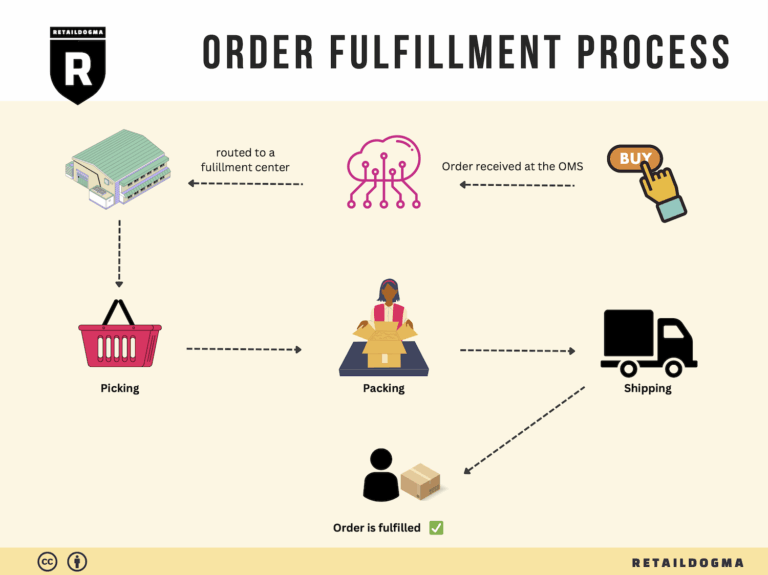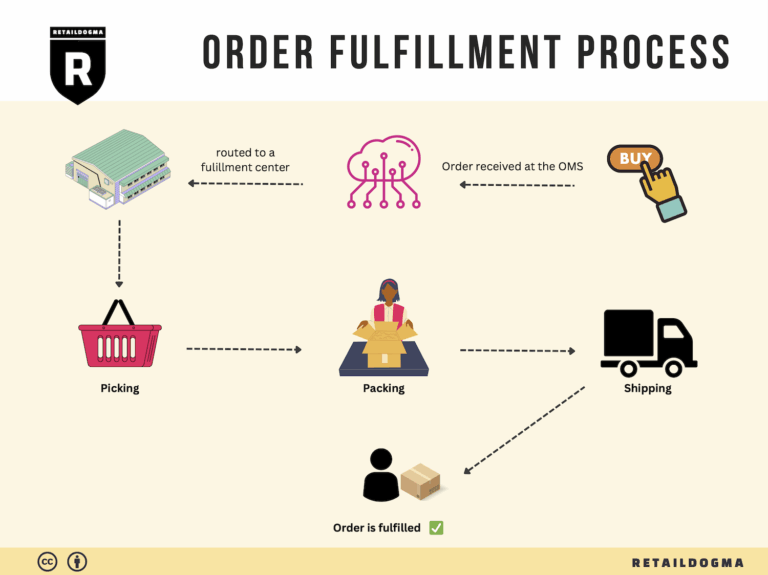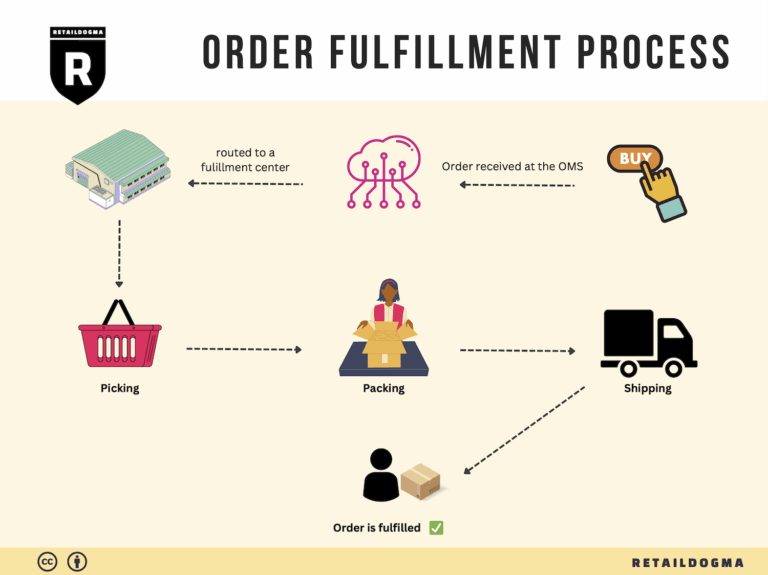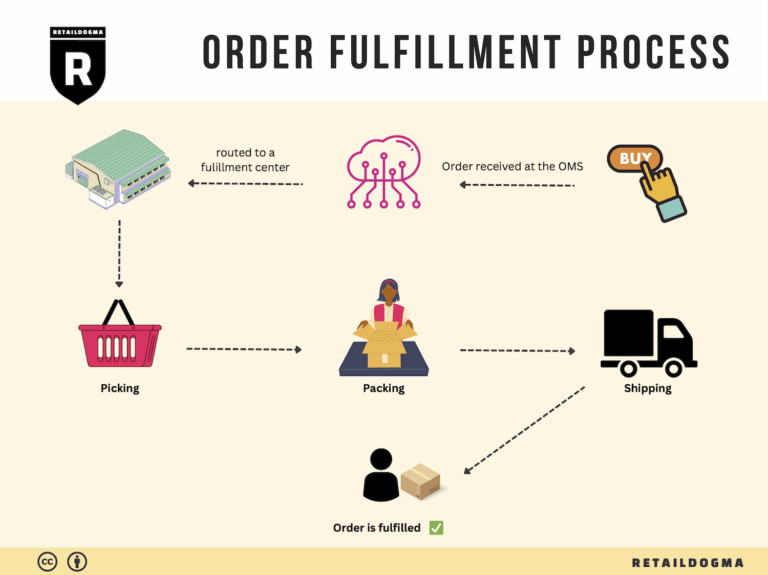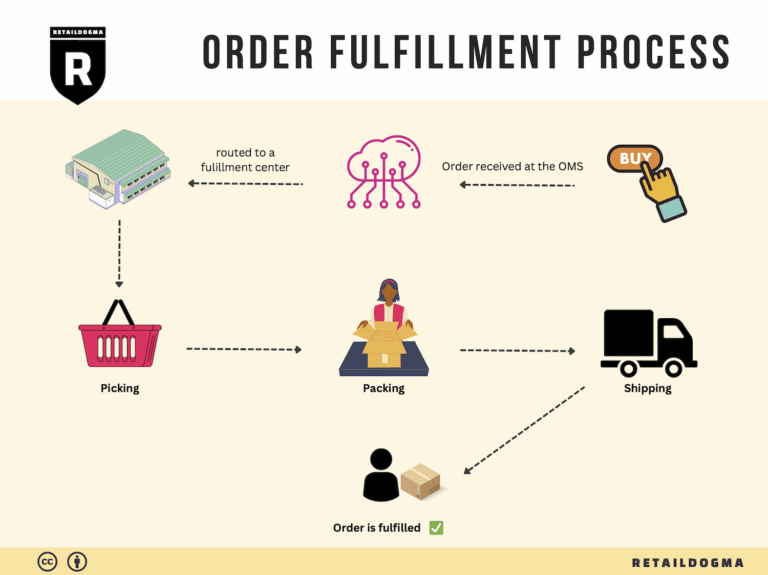How Order Fulfillment Works: A Step-by-Step Guide for Businesses
What is E-commerce Fulfillment? An Introduction for Growing Businesses
Many growing online businesses reach a point where the excitement of sales is overshadowed by the logistical headaches of packing and shipping orders. The thrill of attracting customers can quickly turn into a nightmare of inventory mismanagement, delayed shipments, and mounting customer complaints. This is where the concept of e-commerce fulfillment becomes essential.
What is E-commerce Fulfillment?
At its core, e-commerce fulfillment is the comprehensive process of getting a product from your online store to your customer’s doorstep. This process encompasses everything from receiving and storing inventory to picking, packing, and shipping orders. For businesses scaling their operations, understanding and effectively managing this process is crucial for maintaining customer satisfaction and driving revenue growth.
In this guide, we will explore various fulfillment models that can align with your business needs, including Third-Party Logistics (3PL) and Fulfillment by Amazon (FBA). Each model offers distinct advantages and can significantly impact your operational efficiency and customer experience.
Core Fulfillment Services
We will also delve into the core services that comprise the fulfillment process. These include inventory management, order processing, warehousing, and returns management. Each service plays a pivotal role in ensuring that orders are fulfilled accurately and efficiently, ultimately shaping your customers’ perceptions of your brand.
Choosing the Right Partner
Selecting the right fulfillment partner can make or break your logistics strategy. This guide will provide you with insights on how to evaluate potential partners based on their capabilities, technology, and pricing structures. We will offer practical tips for negotiating contracts and ensuring that your chosen provider aligns with your business goals.
Understanding Pricing
Additionally, we will break down the costs associated with e-commerce fulfillment. Understanding these costs is essential for budgeting and ensuring that your fulfillment strategy is not only effective but also financially viable.
Empowering Smart Decisions
Ultimately, this guide aims to empower e-commerce businesses to make informed decisions about their logistics. With the right knowledge and tools, you can streamline your fulfillment process, enhance customer satisfaction, and focus on scaling your sales without the chaos of logistics weighing you down. Whether you’re a startup or an established brand looking to optimize your operations, mastering e-commerce fulfillment is key to achieving your growth objectives.

What You’ll Learn In This Guide
- What is E-commerce Fulfillment? An Introduction for Growing Businesses
- The Order Fulfillment Process: From ‘Buy’ Button to Customer’s Door
- Comparing Fulfillment Models: In-House vs. 3PL vs. Dropshipping
- A Deep Dive into Amazon FBA: Pros, Cons, and Who It’s For
- Core Services Offered by Fulfillment Centers
- How to Choose a Fulfillment Partner: A 6-Point Checklist
- Understanding Fulfillment Pricing: A Breakdown of Common Fees
- Frequently Asked Questions (FAQs) about Fulfillment
- Conclusion: Is Outsourcing Fulfillment the Right Move for Your Business?
- Important Disclaimer
The Order Fulfillment Process: From ‘Buy’ Button to Customer’s Door
1. Receiving Inventory
The first step in the order fulfillment process is receiving inventory. This involves the arrival of products at the fulfillment center, where they are checked against purchase orders to ensure accuracy and quality. During this stage, staff will inspect items for damage and confirm that the correct quantities have been received. Key terms associated with this step include SKU (Stock Keeping Unit), which is a unique identifier for each product that helps streamline inventory tracking.
Importance: Proper receiving practices are crucial for maintaining accurate inventory levels. Errors at this stage can lead to stock discrepancies, which can cause fulfillment delays and customer dissatisfaction. By ensuring that the right products are received and recorded accurately, businesses can avoid stockouts and maintain a steady flow of operations.
2. Warehouse Storage
Once inventory is received and verified, it is stored in the warehouse. This step involves organizing products in a manner that maximizes space and efficiency, using shelving systems and designated storage areas. Effective warehouse management is essential here, as it dictates how quickly items can be retrieved later in the fulfillment process.
Importance: Efficient warehouse storage reduces the time it takes to locate products during order picking. A well-organized warehouse allows for faster retrieval, minimizing delays in shipping. Additionally, it helps prevent damage to inventory and ensures that products are easily accessible, which is critical for maintaining high service levels and meeting customer expectations.
3. Order Picking
Order picking is the process of retrieving items from their storage locations to fulfill a customer order. This can be done using various methods, such as single order picking, batch picking, or zone picking, depending on the size and complexity of the operation. A pick list is generated for each order, detailing the items and quantities to be collected.
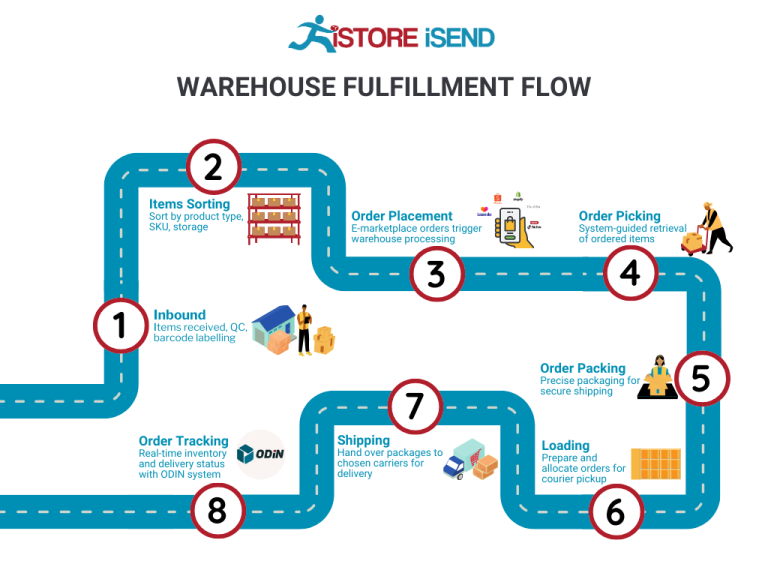
Importance: This step is pivotal because it directly impacts the accuracy and speed of order fulfillment. Mistakes in order picking can lead to customer dissatisfaction and increased return rates. By utilizing technology such as barcode scanners and mobile devices, businesses can enhance picking accuracy and efficiency, ensuring that the right products reach the right customers without delay.
4. Order Packing
After items have been picked, they are moved to the packing station, where they are prepared for shipment. During this stage, products are packed into boxes or envelopes, and shipping labels are generated. Key considerations include selecting appropriate packing materials to protect items during transit and ensuring that the packaging meets shipping carrier requirements.
Importance: Proper packing is essential for preventing damage during shipping and ensuring that products arrive at customers’ doors in pristine condition. Additionally, effective packing can help optimize shipping costs by minimizing package dimensions and weight. This step also involves including any necessary documentation, such as invoices or return labels, to enhance the customer experience.
5. Shipping & Delivery
The final step in the order fulfillment process is shipping and delivery. Once orders are packed, they are handed off to shipping carriers for transportation to the customer’s specified address. Businesses often utilize shipping zones to determine shipping costs and delivery times based on the distance from the fulfillment center to the customer.
Importance: Timely and accurate shipping is critical for customer satisfaction. In today’s competitive e-commerce landscape, customers expect fast and reliable delivery. Partnering with reputable shipping carriers and utilizing tracking systems can help businesses provide real-time updates to customers, enhancing transparency and trust. Efficient shipping practices not only boost customer loyalty but can also lead to repeat business and positive word-of-mouth referrals.
In conclusion, understanding and optimizing each step of the order fulfillment process is essential for e-commerce businesses aiming to scale effectively. By focusing on receiving inventory, warehouse storage, order picking, order packing, and shipping & delivery, companies can enhance operational efficiency and meet customer expectations, ultimately driving sales and growth.
Comparing Fulfillment Models: In-House vs. 3PL vs. Dropshipping
Fulfillment Model Comparison
| Model | Who Handles Inventory | Best For (Business Stage) | Key Advantage | Key Disadvantage |
|---|---|---|---|---|
| In-House Fulfillment | The business itself | Startups to mid-sized businesses | Complete control over inventory and operations | High overhead costs and resource-intensive |
| Third-Party Logistics (3PL) | 3PL provider | Growing businesses | Scalability and reduced operational burden | Less control over fulfillment processes |
| Dropshipping | Supplier/Manufacturer | New businesses or niche brands | Low upfront investment and no inventory risk | Lower profit margins and potential supplier issues |
In-House Fulfillment
In-house fulfillment refers to the process where an e-commerce business manages its own warehousing, inventory management, order processing, and shipping. This model is often adopted by startups and mid-sized businesses that want to maintain full control over their fulfillment processes. In-house fulfillment allows businesses to tailor their operations to their specific needs, ensuring that customer orders are processed exactly as they envision. Additionally, having direct oversight can lead to better quality control and faster response times for customer service issues. However, this model also comes with significant challenges. The costs associated with warehousing, staffing, technology, and logistics can be substantial. As the business grows, scaling operations can become complex and resource-intensive, requiring substantial investments in infrastructure and personnel.
Third-Party Logistics (3PL)
Third-party logistics (3PL) providers offer a robust solution for businesses looking to outsource their fulfillment processes. In this model, the 3PL handles inventory management, warehousing, order processing, packing, and shipping. This is particularly beneficial for growing businesses that need to scale operations without the overhead of managing their own logistics. By partnering with a 3PL, businesses can leverage the provider’s expertise, technology, and established relationships with shipping carriers to achieve faster, more efficient fulfillment processes. Moreover, 3PLs often provide bulk shipping discounts, which can significantly lower costs. However, one of the key disadvantages of using a 3PL is the reduced control over the fulfillment process. Businesses must rely on their 3PL partner to maintain quality and efficiency, which can lead to issues if the provider does not meet expectations. Additionally, switching providers can be complicated and time-consuming, should the need arise.
Dropshipping
Dropshipping is a fulfillment model where the retailer does not hold inventory but instead partners with suppliers or manufacturers who fulfill orders directly to customers. This model is especially appealing for new businesses or niche brands looking to minimize upfront costs and inventory risk. With dropshipping, retailers can offer a wide range of products without the need for significant investment in stock, making it easier to test new products or markets. However, dropshipping comes with its own set of challenges. Profit margins can be lower compared to other fulfillment models, as retailers often have to pay higher prices to suppliers. Additionally, reliance on third-party suppliers can lead to issues such as stock shortages, shipping delays, and quality control problems, which can impact customer satisfaction. As a result, while dropshipping can be a low-risk entry point into e-commerce, businesses must be vigilant in selecting reliable partners and managing customer expectations.
Conclusion
Choosing the right fulfillment model is critical for the success and scalability of an e-commerce business. Each model—whether in-house fulfillment, third-party logistics, or dropshipping—offers distinct advantages and disadvantages that can significantly impact operational efficiency and customer satisfaction. Business owners should carefully assess their current needs, growth trajectory, and financial capabilities before selecting a fulfillment strategy. Understanding the intricacies of each model allows businesses to make informed decisions that align with their long-term goals and customer expectations.
A Deep Dive into Amazon FBA: Pros, Cons, and Who It’s For
What is Fulfillment by Amazon (FBA)?
Fulfillment by Amazon (FBA) is a service provided by Amazon that allows e-commerce sellers to store their products in Amazon’s fulfillment centers. Amazon takes care of the logistics involved in storing, packaging, and shipping the products directly to customers. This service has become a cornerstone for many online businesses looking to leverage Amazon’s extensive logistics network and customer base.
When a customer orders a product listed under FBA, Amazon handles the entire process—from picking the item off the shelf to packing it and shipping it to the customer. Additionally, FBA sellers can benefit from Amazon’s customer service and returns management, which can be a significant advantage for businesses looking to scale quickly.
How FBA Works
The FBA process begins with sellers sending their products to Amazon’s warehouses. Once received, Amazon takes over the inventory management, ensuring that products are stored efficiently. When a customer makes a purchase, Amazon’s sophisticated systems automatically pick the item, package it, and ship it out, often within a day or two.
Sellers can track their inventory and sales through Amazon’s Seller Central, a platform where they can manage their FBA business. They can also utilize Amazon’s tools for marketing their products, including advertising options and promotions, which can enhance visibility and sales.
Pros of FBA
1. Prime Eligibility
One of the most significant advantages of using FBA is that products become eligible for Amazon Prime, which offers customers free two-day shipping. This can dramatically increase a seller’s visibility and sales, as Prime members are more likely to purchase items that offer quick and free shipping.
2. Customer Trust
Amazon is a well-established brand with a high level of consumer trust. By using FBA, sellers can leverage Amazon’s reputation, which can lead to increased conversions. Customers often feel more secure purchasing from sellers whose products are fulfilled by Amazon, knowing they will receive reliable service and support.
3. Multi-Channel Fulfillment
FBA allows sellers to fulfill orders not only from Amazon but also from other sales channels. This means that if a seller sells on their own website or other platforms, they can still use Amazon’s fulfillment services. This flexibility can help streamline operations and reduce the complexity of managing logistics across multiple channels.
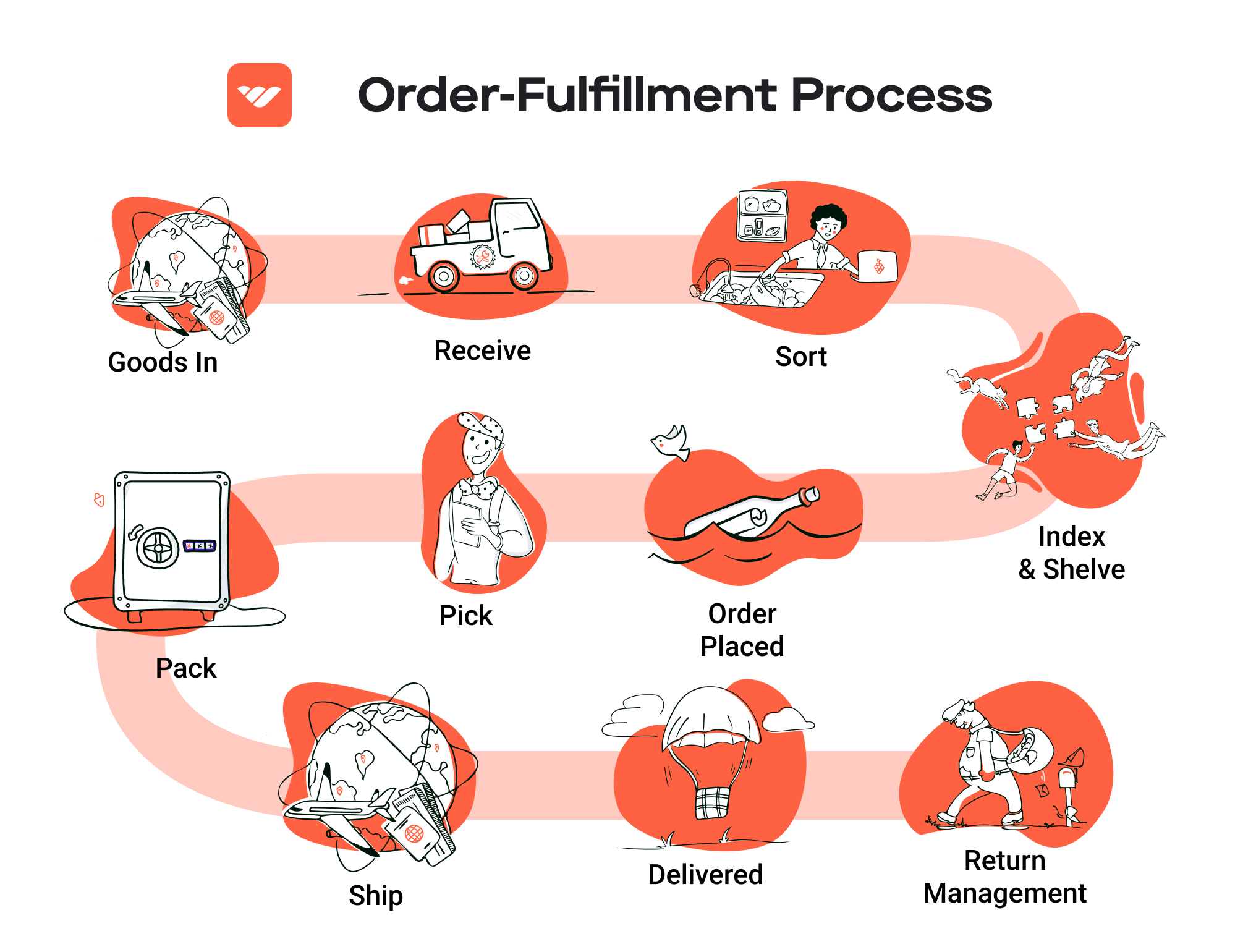
4. Efficient Returns Management
Amazon handles all customer service inquiries and returns for FBA products, allowing sellers to focus on other aspects of their business. This streamlined returns process can enhance customer satisfaction and reduce the burden on sellers.
Cons of FBA
1. High Fees
While FBA provides numerous benefits, it comes at a cost. Amazon charges various fees, including storage fees for inventory stored in their warehouses and fulfillment fees for each item sold. For sellers with low margins, these costs can significantly eat into profits, making it essential to analyze whether FBA is financially viable.
2. Strict Inventory Rules
Amazon enforces strict inventory management rules that sellers must adhere to. This includes limits on the number of units that can be sent to fulfillment centers and requirements for labeling and packaging. Failure to comply with these rules can result in penalties or restrictions on a seller’s account.
3. Commingling Risks
FBA products from different sellers can be stored together in Amazon’s warehouses, which can lead to commingling issues. If a customer receives a product that is defective or not as described, it can lead to negative feedback that affects all sellers whose products are commingled. This risk can be a concern for sellers who want to maintain a high level of product integrity.
4. Loss of Control
By outsourcing fulfillment to Amazon, sellers relinquish a degree of control over the shipping process. This can be problematic if there are discrepancies in shipping times or if products are damaged during handling. Sellers may find it difficult to address issues promptly, as they are reliant on Amazon’s processes.
Who is FBA Best For?
FBA is particularly advantageous for sellers who:
-
Are Looking to Scale Quickly: If a business is experiencing rapid growth and needs to handle a large volume of orders, FBA can provide the necessary infrastructure without the need to invest in logistics and warehousing.
-
Sell High-Turnover Products: Products that have a quick turnover rate can benefit from FBA’s efficiency, as the costs associated with storage and fulfillment can be offset by high sales volume.
-
Prioritize Customer Experience: Businesses that want to offer exceptional customer service and fast shipping can leverage Amazon’s logistics capabilities to enhance customer satisfaction.
-
Are New to E-commerce: New sellers can use FBA to simplify the logistics aspect of their business while they focus on other areas like marketing and product development.
In conclusion, FBA is a powerful tool for many e-commerce businesses, offering significant advantages in terms of logistics, customer trust, and efficiency. However, it is essential for sellers to weigh the pros and cons carefully and evaluate their specific needs and financials to determine if FBA aligns with their business goals.
Core Services Offered by Fulfillment Centers
Inventory Management & Warehousing
Inventory management and warehousing are fundamental components of the fulfillment process that directly impact an e-commerce business’s efficiency and customer satisfaction. Inventory management involves the systematic tracking of stocked goods, ensuring that businesses have the right amount of inventory at the right time. This process includes receiving inventory, monitoring stock levels, forecasting demand, and managing restocking to prevent stockouts or overstock situations.
The warehousing aspect refers to the physical storage of products in a secure facility until they are needed for order fulfillment. A well-organized warehouse allows for easy access to products, which is crucial for timely shipping. Fulfillment centers employ advanced Warehouse Management Systems (WMS) that streamline inventory tracking and optimize storage layouts, resulting in reduced operational costs and increased order accuracy.
Benefits: By outsourcing inventory management and warehousing to a fulfillment center, e-commerce businesses can focus on strategic growth rather than the day-to-day challenges of stock management. Fulfillment centers provide real-time inventory data, enabling businesses to make informed decisions about purchasing and marketing. Moreover, effective inventory management minimizes the risk of lost sales due to stockouts, while optimized warehousing ensures that products are readily available for quick shipping, enhancing customer satisfaction.
Pick and Pack Services
Pick and pack services are at the heart of the fulfillment process, involving the selection of ordered items from the warehouse (picking) and preparing them for shipment (packing). In a fulfillment center, this process is executed with precision and speed, as trained staff utilize efficient picking methods and packing techniques to ensure that orders are fulfilled accurately and quickly.
The picking process can vary based on the fulfillment center’s technology and methods. For instance, some centers use automated systems to streamline the selection of items, while others may employ batch picking to handle multiple orders simultaneously. Once items are picked, they are carefully packed using appropriate materials to prevent damage during transit.
Benefits: The primary advantage of utilizing pick and pack services is the speed and accuracy they bring to order fulfillment. By leveraging the expertise and technology of a fulfillment center, e-commerce businesses can significantly reduce the time it takes to fulfill orders, often achieving same-day or next-day shipping. This not only meets customer expectations for fast delivery but also enhances overall operational efficiency, allowing businesses to handle increased order volumes without compromising quality.
Kitting and Assembly
Kitting and assembly services involve the process of grouping together different products or components into a single package or kit, ready for sale or shipment. This service is especially useful for businesses that sell bundled products or require items to be assembled before they reach the customer. Fulfillment centers that offer kitting and assembly can handle a variety of tasks, such as packaging multiple items together, creating promotional kits, or assembling products that require setup.
Fulfillment centers employ trained staff and specialized equipment to ensure that kitting and assembly are performed accurately and efficiently. This process is often integrated with the overall fulfillment workflow, allowing for a seamless transition from assembly to shipping.
Benefits: The kitting and assembly services provided by fulfillment centers offer e-commerce businesses the ability to enhance their product offerings and streamline their operations. By outsourcing this process, businesses can save time and labor costs, allowing them to focus on marketing and sales. Additionally, well-assembled kits can improve the customer experience and drive higher sales, as customers are often drawn to bundled offers that present value and convenience.
Returns Management (Reverse Logistics)
Returns management, also known as reverse logistics, is the process of handling returned merchandise and reintegrating it into the inventory system. This service includes receiving returned items, assessing their condition, restocking them if they are in sellable condition, and managing customer refunds or exchanges. Efficient returns management is critical for maintaining customer satisfaction and loyalty in e-commerce.
A fulfillment center typically has established protocols for processing returns, which can include inspecting items, sorting them based on their condition, and determining the appropriate action (restocking, refurbishing, or recycling). By utilizing a fulfillment center’s returns management services, e-commerce businesses can simplify this complex process and ensure that returns are handled swiftly and accurately.
Benefits: The benefits of effective returns management are significant. Firstly, a streamlined returns process helps retain customer trust and encourages repeat purchases, as customers appreciate hassle-free returns. Secondly, it minimizes revenue loss by quickly reintegrating sellable items back into inventory, thus reducing the financial impact of returns. Finally, leveraging a fulfillment center’s expertise in reverse logistics allows businesses to focus on growth while ensuring that customer service remains a top priority.
In conclusion, partnering with a fulfillment center for these core services not only enhances operational efficiency but also positions e-commerce businesses for scalable growth and improved customer satisfaction. By understanding and leveraging these services, entrepreneurs and operations managers can create a fulfillment strategy that meets the demands of today’s competitive market.
How to Choose a Fulfillment Partner: A 6-Point Checklist
Location & Warehouse Network
Importance:
The geographical location of your fulfillment partner’s warehouses plays a critical role in shipping speed and costs. A strategically located fulfillment center can reduce shipping times, enhance customer satisfaction, and lower transportation costs.
Questions to Ask:
– Where are your warehouses located, and how do they align with my target customer base?
– How many fulfillment centers do you operate, and what regions do they cover?
– What shipping carriers do you partner with, and do you have established relationships that could benefit my shipping rates?
Technology & Integrations
Importance:
In today’s digital landscape, having a robust technology stack is essential for seamless order management, inventory tracking, and real-time data access. Integration with existing e-commerce platforms and tools can streamline operations and improve efficiency.
Questions to Ask:
– What technology do you use for order management and inventory tracking?
– Can your system integrate with my current e-commerce platform (e.g., Shopify, WooCommerce, Magento)?
– Do you offer real-time tracking for shipments, and how is this information communicated to customers?
Specializations (e.g., Cold Storage, Oversized Items)
Importance:
Different businesses have unique needs based on their product types. If your business involves specialized products such as perishables, hazardous materials, or oversized items, ensure that your potential partner has the capabilities to handle these requirements.
Questions to Ask:
– Do you have experience handling my specific product category?
– What specialized services do you offer (e.g., cold storage, kitting, assembly)?
– How do you ensure compliance with regulations for specialized items?
Scalability & Capacity
Importance:
As your business grows, your fulfillment needs will evolve. A capable fulfillment partner should be able to scale operations in line with your growth without compromising service quality. Assessing their capacity to handle increased order volumes is crucial for long-term partnerships.
Questions to Ask:
– How do you accommodate seasonal fluctuations in order volume?
– What are your current capacity limits, and how quickly can you scale?
– Can you provide examples of how you’ve successfully scaled operations for other clients?
Pricing and Contracts
Importance:
Understanding the pricing structure and contract terms of your fulfillment partner is crucial for maintaining healthy profit margins. Transparent pricing can help avoid unexpected costs that can erode your bottom line.
Questions to Ask:
– What is your pricing model (e.g., per order, per item, monthly fees)?
– Are there any hidden fees (e.g., for storage, picking, packing, or returns)?
– What are the terms of the contract, and what is the process for termination or renewal?
Customer Support & Reviews
Importance:
Exceptional customer support is vital for resolving issues quickly and maintaining smooth operations. Additionally, checking reviews and testimonials can provide insight into a fulfillment partner’s reliability and service quality.
Questions to Ask:
– What level of customer support do you provide (e.g., dedicated account managers, 24/7 support)?
– How do you handle issues or complaints that arise during the fulfillment process?
– Can you provide references or case studies from other clients in my industry?
Conclusion
Choosing the right fulfillment partner is a strategic decision that can significantly impact your business’s operational efficiency and customer satisfaction. By utilizing this checklist, e-commerce business owners and operations managers can ensure they select a partner that aligns with their goals, product requirements, and growth aspirations. Taking the time to thoroughly evaluate potential partners through these six key areas will ultimately lead to a more successful and scalable fulfillment strategy.
Understanding Fulfillment Pricing: A Breakdown of Common Fees
Initial Setup Fees
When partnering with an e-commerce fulfillment center, the initial setup fee is typically the first cost you will encounter. This fee covers the administrative and logistical work required to onboard your business into the fulfillment provider’s system. It may include tasks such as configuring your account, integrating your sales channels with their system, and setting up inventory management tools.
The calculation of initial setup fees can vary significantly among providers, often ranging from a few hundred to several thousand dollars, depending on the complexity of the setup and the features included. Factors influencing this fee include the number of SKUs you have, the extent of integration with your existing systems, and any additional services you may require, such as custom branding on packaging or specialized handling of your products.
Receiving Fees
Receiving fees are charged when your inventory arrives at the fulfillment center. This fee covers the labor and resources required to unload, inspect, and store your products. The receiving process may include checking for damages, updating inventory counts, and organizing products in the warehouse.
Typically, receiving fees are calculated based on the volume of inventory being received, often measured in pallets or individual items. For example, a fulfillment center might charge a flat rate per pallet or a per-item fee that applies to the total number of units received. It’s essential to inquire about how these fees are structured to avoid surprises, especially if you anticipate frequent shipments.
Storage Fees (per pallet/bin)
Storage fees are incurred for the space your inventory occupies in the fulfillment center. This fee can be calculated on a per-pallet or per-bin basis, depending on how the provider structures its storage solutions. The rates may also vary based on the time of year, as demand for storage can fluctuate significantly during peak seasons.
Generally, storage fees are charged monthly, and the cost can vary based on factors such as the type of goods stored (e.g., perishable items may have different rates) and the total volume of inventory. To manage storage costs effectively, it’s advisable to maintain optimal inventory levels and regularly assess your stock turnover to avoid overpaying for unused space.
Pick & Pack Fees (per item/order)
Pick & pack fees are one of the most critical components of fulfillment pricing. This fee covers the process of selecting items from inventory (picking) and packaging them for shipment (packing). Each order will incur a pick & pack fee, which can vary based on the number of items included in each order.
Fulfillment providers often charge a base fee for picking an order, plus an additional fee for each item included in that order. For example, a provider might charge a flat fee for the first item picked and a smaller fee for each additional item. Understanding how these fees are structured can help you optimize your order fulfillment strategy, particularly if you offer bundled products or frequently ship multi-item orders.
Shipping Fees
Shipping fees are the costs associated with transporting your products to customers. This fee is influenced by various factors, including the shipping method selected (standard, expedited, etc.), the destination of the shipment, and the dimensions and weight of the package.
Shipping fees can be calculated using a variety of methods, often based on the shipping carrier’s rates, which fulfillment centers typically receive at discounted bulk rates. Many fulfillment providers allow businesses to pass these discounts on to customers, making your offerings more competitive. It’s crucial to clarify how shipping fees are calculated and whether they are included in the overall fulfillment pricing or charged separately.
Tips for Getting an Accurate Quote
To ensure you receive an accurate quote from a fulfillment center, consider the following tips:
-
Be Detailed: Provide comprehensive information about your products, including dimensions, weight, and any special handling requirements. This will help the provider give you a more precise estimate.
-
Estimate Volume: Share your expected order volume and frequency. Fulfillment providers often offer tiered pricing based on order volume, so understanding your needs can help you secure better rates.
-
Ask About All Fees: Inquire about all potential fees, including any hidden costs such as return processing, customer service, or additional handling. Transparency is key to avoiding unexpected expenses.
-
Compare Multiple Providers: Don’t settle for the first quote you receive. Compare several fulfillment centers to find one that offers the best combination of services and pricing that fits your business model.
By understanding these common fulfillment pricing models and following these tips, you can make informed decisions that will enhance your e-commerce operations and ultimately drive your business’s growth.
Frequently Asked Questions (FAQs) about Fulfillment
1. What is an ecommerce fulfillment center?
An ecommerce fulfillment center is a specialized warehouse designed to store, pick, pack, and ship products for online retailers. These centers streamline the order fulfillment process, enabling businesses to efficiently manage inventory and meet customer expectations for fast and accurate delivery.
2. What’s the difference between a warehouse and a fulfillment center?
While both warehouses and fulfillment centers store products, their purposes differ significantly. A warehouse is primarily focused on inventory storage and may not handle order processing or shipping. In contrast, a fulfillment center is designed specifically for fulfilling customer orders, which includes picking, packing, and shipping items directly to consumers.
3. What is a 3PL?
A 3PL, or third-party logistics provider, is a company that offers outsourced logistics services, including warehousing, fulfillment, and shipping. By partnering with a 3PL, ecommerce businesses can leverage the provider’s infrastructure and expertise to enhance their logistics operations, allowing them to focus on core business functions.
4. How much do fulfillment services cost?
Fulfillment costs can vary widely based on factors such as order volume, storage needs, and specific services required. Typical costs may include per-order fees, storage fees based on the volume of inventory stored, and shipping costs. It’s essential to evaluate different fulfillment providers and request detailed pricing to find the best fit for your business.
5. What are the benefits of using a fulfillment center?
Utilizing a fulfillment center can provide numerous advantages, including:
– Increased efficiency in order processing and shipping.
– Access to advanced technology and systems for inventory management.
– Scalability to handle fluctuating order volumes without the need for significant upfront investment.
– Enhanced customer satisfaction through faster and more accurate deliveries.
6. How does the order fulfillment process work?
The order fulfillment process typically involves several key steps:
1. Receiving inventory at the fulfillment center.
2. Storing products in an organized manner.
3. Processing customer orders as they come in.
4. Picking the correct items from the inventory.
5. Packing the items securely for shipment.
6. Shipping the packages to the customer’s address.
7. Handling returns and restocking items as necessary.
7. Can I manage my own fulfillment instead of outsourcing?
Yes, many businesses start by managing their own fulfillment, especially when they are small. However, as order volume increases, it often becomes challenging to maintain efficiency and accuracy. Outsourcing to a fulfillment center or 3PL can save time, reduce errors, and allow you to focus on growth and strategy.
8. What technology is used in fulfillment centers?
Fulfillment centers typically use a variety of technologies to optimize operations, including:
– Warehouse Management Systems (WMS) for inventory tracking and order management.
– Barcode scanning systems to ensure accuracy in picking and packing.
– Shipping software to manage carrier relationships and shipping rates.
– Real-time analytics tools to monitor performance and inventory levels.
9. How do fulfillment centers handle returns?
Fulfillment centers have established processes for managing returns, often referred to as reverse logistics. When a customer initiates a return, they send the product back to the fulfillment center, where it is inspected and processed. Depending on the condition of the item, it can be restocked or returned to the supplier. Clear communication with your fulfillment provider about their returns process is crucial for maintaining customer satisfaction.
10. How can I choose the right fulfillment provider for my business?
When selecting a fulfillment provider, consider the following factors:
– Their experience and reputation in the industry.
– The range of services offered, including shipping options and returns management.
– Technology capabilities, such as integration with your ecommerce platform.
– Pricing structure and transparency.
– Location of fulfillment centers relative to your customer base, as this can impact shipping speed and costs. Conducting thorough research and requesting proposals from multiple providers can help you make an informed decision.
Conclusion: Is Outsourcing Fulfillment the Right Move for Your Business?
Evaluating the Benefits of Outsourcing Fulfillment
Outsourcing your fulfillment process can be a transformative decision for your e-commerce business. The key benefits include substantial time savings, enhanced scalability, and access to specialized expertise. By partnering with a fulfillment service, you can delegate time-consuming tasks such as inventory management, order processing, and shipping logistics, allowing you to focus on strategic growth initiatives. This not only streamlines your operations but also improves your ability to respond to market changes and customer demands swiftly.
Moreover, scalability is a significant advantage. As your business grows, so does the complexity of your fulfillment needs. A proficient fulfillment partner can efficiently manage increased order volumes and facilitate expansion into new markets without the overhead of establishing your own warehousing and logistics infrastructure. This flexibility allows you to scale operations seamlessly, ensuring that you can meet customer expectations for fast and reliable delivery.
Importantly, choosing the right fulfillment partner is crucial for your success. A knowledgeable provider can offer insights and technology that enhance your fulfillment strategy, ensuring that your logistics run smoothly and cost-effectively. Their expertise can help you navigate challenges like inventory forecasting and returns management, ultimately contributing to a more satisfying customer experience.
Call to Action
As you consider the potential of outsourcing fulfillment, take a moment to audit your current shipping and fulfillment processes. Assess your operational efficiency, customer satisfaction levels, and growth objectives. This evaluation will help you determine whether a fulfillment partner is the right next step for your business. Investing in the right partnership could be the key to unlocking your e-commerce potential and driving sustainable growth.
Important Disclaimer
⚠️ Important Disclaimer
The information in this guide is for educational purposes. Fulfillment services, pricing, and platform features change frequently. Always conduct your own due diligence and consult with providers directly before making business decisions.


